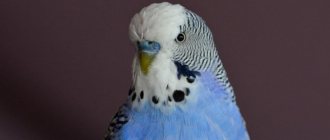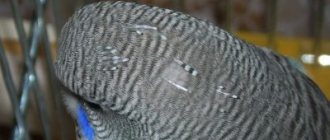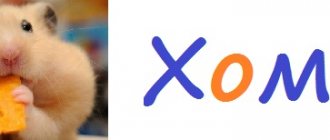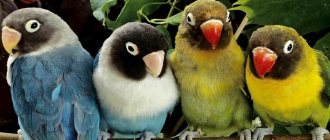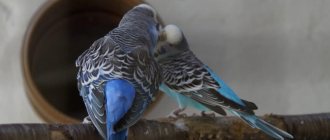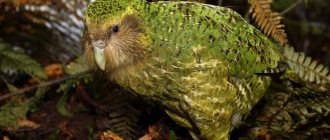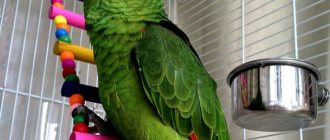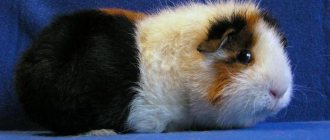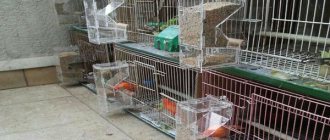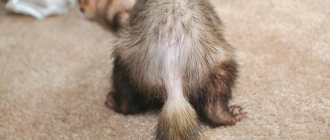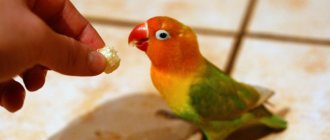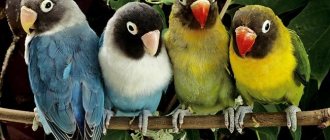- home
- Parrot
- Care
05/24/2019 Breeding budgies is a profitable and interesting business, but it also requires a lot of responsibility. Feathered parents selflessly take care of newborn wavy birds, but often they need help and support from the owner. The responsibility of the owner of a family of parrots is to be ready to help the birds at the right time when they cannot cope on their own. In addition, the responsibility for the proper nutrition of the pets falls on the shoulders of the breeder, as well as for creating comfortable living conditions for both the parrots and their chicks.
How do parrots lay eggs?
Birds at least 1-1.5 years old are allowed to mate. To encourage a pair of parakeets to reproduce and procreate, you need to place a nest or a special wooden house in the parrots’ cage. The recommended time for reproduction is the warm season of the year.
It is necessary to lay straw or sawdust at the bottom of the family nest. The expectant mother will continue further arrangement of the nest on her own. After the creation of comfort is completed, the parrots will begin the mating period, which will end with mating.
Typically, the period between installing the nest and the start of filling it with eggs is 2-3 weeks. Determining whether the female is ready to lay eggs is not difficult. Characteristic signs of such a bird:
- rounded lower abdomen;
- tail twitching as you inhale and exhale.
Sometimes a young and inexperienced feathered mother lays eggs outside the nest. If such an egg is found, it is recommended to carefully move it to the nest.
The parrot lays eggs at intervals of one every 1-2 days. Having laid the second egg, the feathered parent begins to hatch the clutch. The total number of eggs in one clutch ranges from 4 to 12 pieces. But not all of them will produce parrot chicks - some of the laid eggs may turn out to be defective. You can distinguish eggs with chicks from “dummies” by their color:
- Fertilized eggs are characterized by a uniform matte color;
- Rejected “dummies” are characterized by yellowness and spotted color.
Signs of an older bird
If a parrot at the age of 8-10 months can be easily confused with an individual that is already 3-5 years old, then you can recognize an old bird.
Signs of an elderly bird:
- over the years, the plumage around the eyes disappears;
- the pupil is cloudy, often with a whitish spot in the middle;
- the plumage loses its rich color, becomes dull, and bald patches appear in places;
- the tail has bald spots (sometimes there are no feathers at all).
Behavior also reveals old age. “Old people” are not so active and inquisitive, they move little, they prefer to sit, occasionally flying to the next perch.
The appearance of chicks
Budgerigar chicks hatch 18-20 days after the corresponding eggs are laid (that is, the difference between the appearance of chicks is equal to the intervals between the laying of eggs from which they subsequently hatch). To be released into the wild, the chick will have to break through the shell surrounding it. The egg tooth at the top of the beak is designed for this purpose.
Only well-developed and healthy, strong and energetic offspring can break through the shell on their own. If the chick shows signs of life inside the egg, but cannot get out, the mother helps him free himself by breaking through the hard shell with her beak. In the process, she eats pieces of the shell, replenishing the calcium content in the body.
The success of the emergence of small birds from the shackles of the shell is affected by air humidity. The recommended value is 60-65%. At lower levels, the air will be too dry, which will cause additional difficulties when hatching babies. The film, located under the shell, will wrap itself like a cocoon around the chick and stick to its body, so the mother will have to save the offspring by tearing its “packaging”.
Artificial feeding
Sometimes situations occur when the female abandons her children, and the role of parents of the parrots has to be performed by the owners themselves, feeding without the help of the real father and mother.
It is important to know: if a newly hatched chick does not eat for more than 12 hours, it may die.
Reasons for switching to artificial nutrition at home:
It is important to know
: depriving a barely born chick of food for more than 12 hours is critical and can cause death. It is necessary to remember this deadline and have time to prepare food. Sometimes the remaining one chick may be placed with an outside pair of parrots or another species of bird. They will become the baby's adoptive parents, although the chance of the chick's survival decreases; otherwise, the owner of the birds should take care of feeding. The best candidates for this role would be Japanese finches; other types of parrots often refuse to accept a stranger and can injure or peck at him.
For fledgling babies, it is important to maintain optimal temperature and humidity. To do this, periodically spray the nest with clean water. The temperature in it should be maintained at 33 °C, lower or higher will cause the death of the birds. The process can be organized using a cardboard box, constantly heating its bottom. You can put a warm towel and use an incubator with a setting that is optimal for chicks. From the twenty-first day, the thermoregulation of young animals is improved; additional heating is not required.
Most experienced breeders advise feeding babies with slightly diluted baby food, heated to 37 °C.
A chick that is two days old is given food using a regular insulin syringe or a catheter (cannula) attached to it, made of a plastic tube wound with a thread. It is necessary to move the tip further away, preventing food from entering the trachea and choking the baby. If the bird is not weakened, it immediately begins to swallow food from the first drop. You need to feed until completely full every two hours, even at night. Such food is given for no more than 2 days - it is not intended for long-term feeding of chicks. Remains of food stuck to the baby's beak should be washed off with chamomile decoction, preventing the growth of bacteria and parasites. In small birds, food sometimes gets stuck in the beak, leading to cracks; you need to remove the remaining food with a toothpick. Sometimes female parrots do not clean the paws of their babies, food debris and droppings accumulate on them, hardening as they accumulate. In this case, you will have to wash the baby yourself.
When artificially feeding with a cannula, food is poured not into the beak, but into the crop, this will prevent the chick from choking on the contents. You can prepare the following mixture: part baby food, two parts millet decoction, one part oat decoction, part solution with glucose, vitamins, amino acids.
What do newborn chicks look like?
It cannot be said that newly born small budgies are pleasing to the eye. In these creatures it is difficult to recognize the feathered beauties that they will become later. Newborn body:
- translucent;
- Pink colour;
- naked (with a maximum of a couple of fluffs on the back).
The baby's build is disproportionate - a small body with thin legs and tiny wings is crowned with a large head on an excessively long neck. This physiology does not allow the baby to take a position other than lying down.
Natural feeding
Newborn chicks are helpless creatures that are completely dependent on their mother. As a rule, the female takes care of each baby, regardless of their number. The baby's first food is goiter milk, which accumulates in the mother's body. It contains not only mucus secretions, but also liquid pieces of food, which contain many vitamins, valuable microelements and proteins. Therefore, the expectant mother should be given a ground chicken egg; in addition, permitted vegetables and herbs can be added to it. Millet, oats and sprouted grains are very useful.
After three days, the female dilutes her milk with a nutrient mixture, which she accumulates in the crop in advance. Gradually, such food becomes constant, but the younger chicks still eat crop milk.
Caring for budgerigar chicks
Of course, the main care for budgerigar chicks is provided by their mother. She feeds them, warms them with the warmth of her body, protects them from possible misfortunes and does not leave them unattended.
But if the main responsibility for the babies falls on their mother, and the owner’s help may be required only as a last resort, then caring for the feathered parents is the responsibility of the breeder. Parrots that become parents need double care and preventative care.
Natural and artificial feeding
The mother feeds the barely born babies. She gives the chicks food from her own beak, after turning the babies onto their backs. At first, the food for babies is crop milk - a healthy and nutritious liquid mixture formed in the crop of the feathered mother.
Gradually, the mother switches the chicks to denser food. 4-5 days after the babies are born, she feeds them with a semi-digested grain mixture, which she collects in advance in the crop. Every day, the mother changes the proportions of the babies’ diet - increases the grain component and reduces the dairy component. Thus, the chicks gradually switch to dense food.
It is worth noting that the father also makes a crop reserve, in case the chicks do not have enough food stored by the mother.
Artificial feeding should replace natural feeding only in the following cases:
- aggressive or hostile attitude of parents towards their offspring;
- the need to isolate healthy birds from sick ones;
- lack of food for the brood among adult parrots;
- death of feathered parents.
Under such circumstances, the breeder will have to feed the budgerigar chicks on his own. Feeding babies is goitrous, so to feed food you will need a special device - this is a syringe for 5 cubes with a tube with a diameter of 2.5 mm made of soft rubber, worn instead of a needle.
As for the menu, it is worth including special food for chicks (sold in pet stores), supplementing it with:
- decoction of millet or oats;
- malt from sprouted grains mixed with a chicken egg;
- boiled porridge of oatmeal, buckwheat or peas, slightly flavored with carrot or beet juice.
Feeding must be carried out according to the schedule:
- during the day – every 2 hours;
- at night - every 4 hours.
But if the birds require food at other times, you should move away from the schedule and feed the chicks. It is not difficult to understand that babies want to eat - hungry budgerigar chicks squeak loudly and shrilly.
The birds are fed through a syringe until they are 3 weeks old. Then they are transferred to spoon feeding, 4 meals a day (again, if this is enough for the parrots). Birds begin to feed dry grain mixture only after they learn to fly.
Composition of mother's diet
If before and during laying eggs the parrot needs protein food (cottage cheese and boiled eggs), then after the clutch is ready, protein products should be excluded from the bird’s diet and it should be switched to grain food.
Mommy's diet should be balanced and include enough vitamins. Therefore, dry grain mixtures need to be supplemented with:
- vegetables;
- greens, grass, dandelion leaves;
- sprouted grains (millet, etc.).
Creating a microclimate
Providing a family of parrots with comfortable living conditions is entirely the responsibility of the owner. Chicks need a certain temperature regime. In the first days of life, the temperature around the babies should be +36°C, then it should be reduced to +30-32°C, and for 3-week-old birds the desired temperature level is +24°C.
Nest care
When the chicks reach 2 weeks of age, their home needs to be thoroughly cleaned. To do this, babies are placed in a pre-prepared box (necessarily with insulation).
The nest is thoroughly cleaned of all accumulated debris and other contaminants. But, despite the thoroughness, cleaning must be done very quickly - the longer the chicks are in the box, the higher the risk of hypothermia.
It is also worth noting that cleaning is necessary not only for the nest, but also for its inhabitants. The chicks should not be dirty - neither with food nor with anything else. This is especially true for their paws - due to adhering dirt, they can become deformed during the growth process. Therefore, it is necessary to clean the babies from dirt in warm water.
Conditions for reproduction
It is advisable for a breeder who decides to breed budgerigars to have several pairs. This will allow, in case of possible problems with the chicks or clutch, to save the offspring and preserve the health of the adults.
Right to breed
Breeding budgerigars at home is not regulated by law; anyone can do it. But to officially register his activities, the breeder must have a license, which is issued by the Society of Bird Lovers. A person needs to confirm that he has knowledge about the breeding and maintenance of budgerigars.
It is the responsibility of veterinarians to check birds for psittacosis. This viral infection can infect not only animals and birds, but also humans. If the test does not reveal this disease, the owner receives official permission for breeding. He is given permanent rings containing information about the breeder, the serial number of his bird, the date and time of registration. During disease outbreaks, this makes it easier to track the location of parrots.
Choosing the right pair
To get healthy offspring, you need to organize the correct selection of a pair of wavy birds. They must be from different parents to prevent the development of genetic diseases in the chicks. How to understand that a male and a female are suitable for each other?
Both parrots should be healthy, active and well-fed. Weak or elderly birds often lay unfertilized eggs. Puberty of females occurs in the second year of life. In males, this period begins a little earlier, from ten months of age. The peak of fertility in wavy birds is observed at the age of 2–4 years. Although parrots breed up to 10 years old.
You might be interested in: Where do parrots live: habitat of popular species of parrots
This is interesting! A budgerigar remains attached to its partner for life. Without mutual sympathy, reproduction does not occur.
Suitable period for breeding
The optimal time for breeding wavy plants at home is the summer months, from June to September. This is the part of the year when parrots get enough sunlight and vitamins. In other periods, they may be weakened due to a deficiency of substances necessary for the body. And this can affect the health of the offspring.
If breeding of parrots is planned for the winter or spring months, the birds must be provided with enhanced nutrition with fresh herbs. At least 14 hours of daylight are required; illumination with a special lamp is allowed. The air temperature must be at least 23 degrees.
Parrot mating process
What conditions need to be created
In addition to selecting a pair, the breeder should think about creating conditions for reproduction. To do this, you need to choose a cage that is suitable in size for the birds. The size of the housing for one pair of wavy plants is 80 cm in length, 40 cm in height and 35 cm in width. If one cell contains several pairs, then these dimensions should be larger.
Females need houses with nests where they can hatch their offspring. When the parrot begins to lay eggs, the cage is placed in a quiet corner so that the bird is not disturbed. The room temperature must be maintained at least 20 degrees. At the same time, heat and stuffiness should not be allowed, as this poses a threat to the embryos.
Feeding parrots during the breeding season
The budgerigar's menu includes grains and seeds, as well as fruits and vegetables.
To stimulate the sexual instinct, the diet should contain the following foods:
- low-fat cottage cheese;
- greenery;
- sprouted grains;
- egg white;
- special mineral supplements.
When a female parrot lays eggs, she requires an increased diet. Products high in vitamin E are very useful. Experienced breeders advise feeding their pets a mixture of cottage cheese, eggs, carrots and sprouted grains.
You might be interested in: How to choose a budgie: preparation, choice of bird, adaptation
It is important to know! Obese or underweight birds are not suitable for breeding. The pair must be fattened before breeding, but not excessively
Chick development
A newborn parrot is deaf, blind and completely helpless. The tiny baby is not even able to hold his head up on his own. He weighs only 1 g, but after 3 days of birth his weight will increase 5 times. Body weight gain and development in wavy birds occurs rapidly - by 20 days of age (maximum one month), birds become parental copies and are practically in no way inferior to adult parrots.
During the first week after birth, the budgerigar chick gradually gains vision, and fluff appears on its body. The shade of the down allows you to judge the color of the bird's future plumage:
- if the fluff is gray, then the color will be traditional, colored;
- if the fluff is light, then the plumage will be white.
On the 6th day, the chick's egg tooth falls off, making it possible to raise its head. Training strengthens the neck muscles, so a week-old parrot can already hold its head up and even try to sit up.
During the second week of birth, the bird learns to use its vision and develops coordination of movements. A two-week-old wavy is covered with down, and the first feathers appear on its wings and crown.
On the 20th day of development, the sex of the bird can be determined by the wax (growth above the beak), and the color of the plumage is formed. The feathers on the tail and the flight feathers on the wings begin to grow. A month-old parrot weighs 40-50 g (like adult birds), is fully feathered, but the tail and wings are still in the development stage. Outwardly, the chick already seems to be an adult, but in its awkward movements one can discern a young bird. At the beginning of the second month, the chick tries to fly for the first time.
What vitamins should be given to a parrot?
One of the important elements for the full development of poultry is calcium. It makes up about 1.5% of the bird’s weight and is responsible not only for the formation of bone tissue, but also for blood clotting, proper metabolism, the functioning of the nervous system, fetal development and shell formation.
How well calcium is absorbed depends on a helper vitamin called D3. It regulates the process of calcium absorption in the stomach and controls the production of hormones that help remove excess nutrients. Vitamins for parrots kept in captivity must include D3, because domestic birds most often lack it. This vitamin is produced during sun exposure. Since domestic parrots are practically deprived of this opportunity, they can only get it from special supplements.
Parrots also have an urgent need for vitamin A. This organic substance affects almost all body systems: cardiovascular, digestive, and hormonal. When listing vitamins that are vital for a parrot, veterinarians always name vitamin A. Because it is involved in many processes in the development and life of the bird.
During molting, during the period of reproduction and the occurrence of certain diseases, the amount of ascorbic acid produced in the bird’s body sharply decreases. Its deficiency contributes to a decrease in immunity and, as a result, frequent illnesses. To compensate for the lack of vitamin C, birds are given vitamins for parrots, which contain this organic substance.
If you have a bird and want to seriously breed it in the future, be sure to give it vitamin E. This substance affects reproductive function and guarantees the appearance of healthy offspring. The amount of vitamin E in the body determines the pet’s appetite, its energy, and even coordination of movements.
When talking about what vitamins should be given to a parrot, one cannot fail to mention B vitamins. This category of organic substances does not accumulate in the body, and therefore their reserves must be replenished daily. If this is not done, you can forget about health, beautiful plumage, strong offspring and easy learning. I would like to talk in more detail about the significance of one of the most important vitamins of the group.
How to tame a chick
It is recommended to begin taming a young parrot when it has already become independent - i.e. will be removed from his parents. First, you need to be present at the bird’s cage during its meal, cleaning its feathers, etc. If the pet behaves calmly and the presence of the owner does not bother him, it is worth moving on to the next stage.
When communicating with the bird in a gentle tone, you need to give it a treat through the bars of the cage. After some time, after a series of such exercises, it is worth giving the treat in the palm of your hand through the cage door. You need to move smoothly, while constantly talking affectionately to your pet.
Then you can remove the feeder from the cage at night, and in the morning try to feed the bird from the palm of your hand. Feeding can be combined with trying to play with your parrot's toys. All this will make it clear to the baby that in the hands of the owner there is no danger or threat for him.
Lifespan
The average lifespan of domestic budgerigars is 8-10 years. In favorable conditions and with proper care, they can live 12-15 years. There are often long-livers whose age has reached 20 years or more.
The lifespan of birds is positively influenced by the following factors:
- nutritious, balanced diet;
- regular feeding with mineral mixtures;
- quality drinking water;
- maintaining hygiene;
- a spacious, clean cage in a warm room that is periodically ventilated;
- proper lighting;
- systematic walks (it is advisable for the parrot to fly out of the cage every day);
- regular examination and timely treatment;
- frequent contact with the pet and friendly communication.
Parrots are sensitive and vulnerable birds. They pick up on a person’s negative emotions and have a hard time withstanding aggression and shouting. Stress can cause them illness and even death. Therefore, it is very important to show them kindness and care. In a friendly environment, parrots are active and sociable. They easily make contact, quickly learn to speak and willingly reproduce when there is a pair.
In the wild, budgerigars live 3-5 years. They often die from lack of food or become prey to predators. It is thanks to the creation of favorable conditions that domestic birds live much longer than their wild counterparts.
Where does “homeland” begin?
Ornamental parrots begin to “engage in prolongation of their kind” when they reach two years of age.
Despite the fact that they can have offspring at any time of the year, it is still recommended to exclude the winter period, since at this time the day length is short, the sun does not shine for that long, and there is no fresh green food, which is so needed by the younger generation.
Due to the fact that this type of ornamental poultry does not build nests, you should hang a special nesting box in their cage, in which you need to pour sawdust.
Most ornithologists categorically prohibit the use of thick threads to insulate the nest box. It would seem that pets will only be delighted with such a cozy nest, but it is not at all impossible that they can get entangled in them and get seriously injured.
The chick died. Why?
It always hurts a lot when you find a dead chick in a nest. Nothing seemed to foretell trouble. There are several reasons for the death of newborns:
- lack of food;
- hypothermia;
- underfeeding or mother abandoning offspring;
- aggressive attitude of one of the parents;
- an inexperienced mother could accidentally crush the baby;
- attack by a female ready for a new clutch.
Why can a parrot die?
A person who is going to seriously engage in breeding budgies at home must realistically imagine all the difficulties and pitfalls of this business in order for it to be successful.
Reasons for artificial feeding
Why is it necessary to feed newborn budgies yourself? The reasons are varied:
A newly born bird can go twelve hours without food, so you can prepare to feed it if necessary. The baby can be placed with another pair or male. Sometimes the bird accepts it and begins to care. But most often it depends only on you whether the bird will live or not.
If the female is preparing for the appearance of new offspring, the previous one may interfere with her. In this case, you will have to quickly find new housing for the chicks. This process usually begins when they can feed themselves. But it happens that the female begins to show aggression quite early, and then the little wavy animals need to be rescued.
So we have grown up...
When the chicks are 35–40 days old, they are already out of the nesting house and are able to fly freely and get food on their own. Interestingly, older brothers and sisters feed the younger ones, who do not yet know how to find food themselves.
In young animals of this age, the plumage becomes quite strong, helping the parrots feel stability and confidence in their first flight. The daily opportunity to fly freely is an indispensable condition for the health of birds.
Grown-up chicks should be transferred to a separate cage. The grown chicks are left in the parent's nest for another two weeks. Then they should be moved to a separate cage that is spacious enough so that they have the opportunity to actively move, fly freely and continue to grow up.
After the young birds have left the nesting site, you need to check if there is a new clutch there.
If eggs stained with droppings are found in the house, they should be carefully wiped off and returned to their place.
Carrying out cleaning work
Hygiene comes first. As a rule, two weeks after the chicks are born, it is necessary to carry out the so-called general cleaning of the nest box.
First of all, it is necessary to get rid of eggs that are unfertilized. Otherwise, an infection may develop rapidly in the nest with the younger generation. Next, you should clean the nest of debris that has accumulated after the chicks spent two weeks in it.
What to do with young parrots and eggs, from which other chicks will soon hatch? Good question. Before you start cleaning the nest box, you need to prepare another container that is comfortable for the chicks and eggs. For example, it could be a cardboard box insulated with material.
When transferring the babies to another box for temporary stay, spend at least half a minute on each chick, inspecting it for dirt, dry food and other foreign objects that could stick to it.
At first glance, it may seem that pieces of food cannot harm a growing organism. But that's not true. Firstly, hygienic care of the growing generation must be observed, and secondly, a stuck lump of dirt can become an obstacle to the full development of the baby’s limbs.
If you suddenly find dirt on the chick's limbs, then you need to immediately lower the chick's legs into a bath of warm water and let the dirt soak. In no case should you try to remove dirt with your fingernail or a towel, since such manipulations can damage the integrity of the chick’s vulnerable skin.
So, after cleaning the nest, you need to place fresh sawdust in it. Many ornithologists strongly recommend the use of birch sawdust; they are considered less dangerous for the offspring of parrots. After the fresh sawdust is in the nesting box, you need to carefully move the babies to their usual house and put the nesting box in the cage in its original place.
One very important nuance - such hygienic care for baby budgies should be carried out as quickly as possible. If you delay the general cleaning, the clutch and chicks may become hypothermic, which will lead to the death of both the first and the second.
Some qualified ornithologists recommend acquiring several nesting boxes at once, so that cleaning will be thorough, unhurried and complete. However, not every owner of a budgerigar can provide such conditions, so it is recommended to replace the sawdust in the nest box at least once a week.
